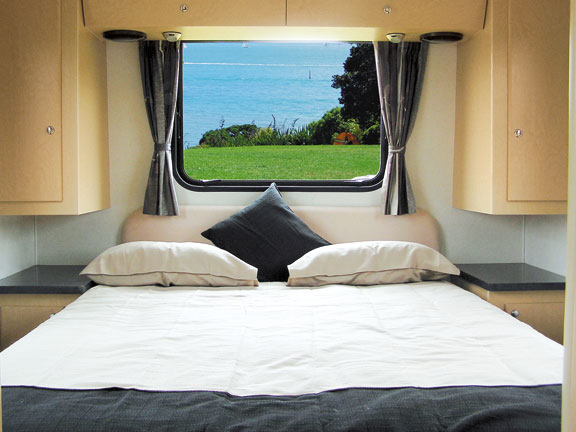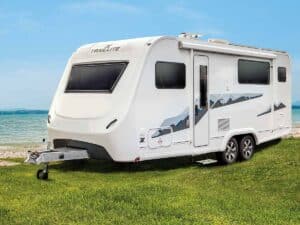- Well designed and spacious interior
- Plenty of room around the double island bed
- Generous window space
- Storage opportunities in abundance
- Hydraulic or electric brake option
At a workshop in New Plymouth, a team of five tradesmen at Silver Fern Caravans produce a range of seven different caravan models.
The caravans are distributed by Village Autos, which has been in the motorhome sales and bus conversion industry for 15 years, venturing into caravan manufacture only six months ago, says Clive Ritchie, who heads the company's recreational vehicle sales team.
“The caravan side of the business is not actually a division of Village Autos,” he explains. “It is a separate company called Silver Fern Caravans, which has its own production factory.
They’re looking at producing a caravan which is a little bit up-market rather than to manufacture them in huge volumes, eventually producing one and a half to two caravans a week.
Exterior
The tandem-axle 6.1m model reviewed sports eye-catching graphics along the length of its fibreglass sides.
There is generous window space, with the ability to look straight through the front and back windows when towing.
The overall design of the Silver Fern range was European-inspired. The manufacturers opted for a fibreglass body in preference to aluminium, and like the sides, the one-piece GRP (glass-reinforced plastic) roof is seamless. The fully welded aluminium frame is mounted on a galvanised chassis.
There is storage room for two gas bottles in a locker, which is located behind the stone guard at the front of the caravan. A second storage area at the rear of the van is located below the queen-sized island bed.
The base of the bed is mounted on gas struts, enabling it to be lifted easily, and the space below accommodates the free-standing table. There is also sufficient room for the spare wheel.
The Silver Fern 610 comes with an 82-litre fresh water tank as standard. Extra conveniences range from an electric-step 240-volt external power outlet, a rear bumper to offset the likelihood of a dent when backing, through to sand pads on the caravan's legs.
Interior
The sculpted lines of the joinery are carried right through the caravan – from the curved seating lounge arrangement at the front, to the overhead lockers along the sides.
Lighting is a 50/50 mix of LED and candescent bulbs. Because they are easier on the leisure battery, plans further down the track are to use LED lighting exclusively.
The Silver Fern has all of the modern conveniences that one would expect in a caravan in this price range.
The Spinflow Caprice Mark three/four-burner gas stove and oven has a rangehood and sits at the end of a generous work-bench/stainless steel sink area.
There's a 240-volt Zip microwave sited at a sensibly accessible height and a large slide-out pantry.
The bathroom is small but functional and is fitted with a Thetford cassette toilet, variable height flex hose shower, and a small hand basin.
In the bedroom, a queen-sized foam mattress sits atop the lift-up base-board. There is plenty of storage room with lockers both either side of the bed as well as overhead.
Towing
With a tare weight of 1650kg, the Silver Fern 610 is designed to be comfortably towed by mid-range vehicles in the 3.0-litre class and above.
Buyers are offered the choice of either hydraulic or electric brakes.
Market positioning
Clive believes there is a resurgence of interest in caravaning, partially sparked by the escalating cost of motorhomes.
New emission laws and an inability to import second-hand buses at a reasonable cost have also prompted increased caravan manufacture.
“The whole motorhome, bus conversion scene has changed now because of the new emission laws,” says Clive.
“The ability to be able to import second-hand buses at a reasonable cost has gone out the window. From January next year we won't be able to import a second-hand bus manufactured before 2007, so you are virtually talking new buses. This has made it too expensive for people to do these conversions.
“We also used to import second-hand American motorhomes to convert and sell. This enabled people to buy a motorhome at a reasonable cost, but with this option closed to us we have had to look at other ways of utilising our resources both in terms of staff and factories.
“Over the last four to five years we started importing caravans from the United States. We found that these were just a little on the heavy side. Also, they don't have the large windows, which the New Zealand public seem to like.”
Australian caravans also lack the large windows for obvious reasons – dust and the fact that they are very conscious of insulation. The bigger the windows, the harder it is to insulate, double glaze and retain the warmth.
Read in-depth RV reviews in the latest issue of Motorhomes, Caravans & Destinations magazine, on sale now.
Specifications
Length 6100mm
Width 2400mm
Freshwater 82L
Grey water Optional
Brakes Hydraulic or electric disc brakes
Fridge Three-way
Hot water 22L gas/240-volt









